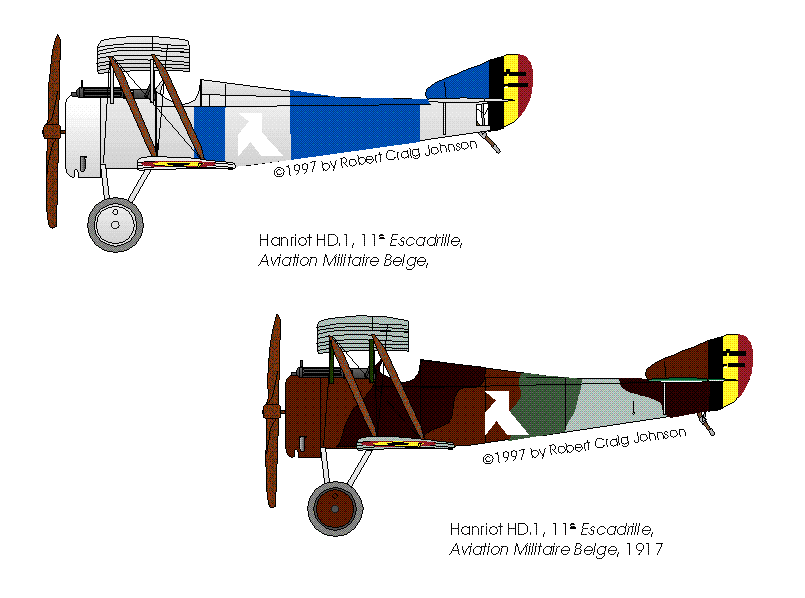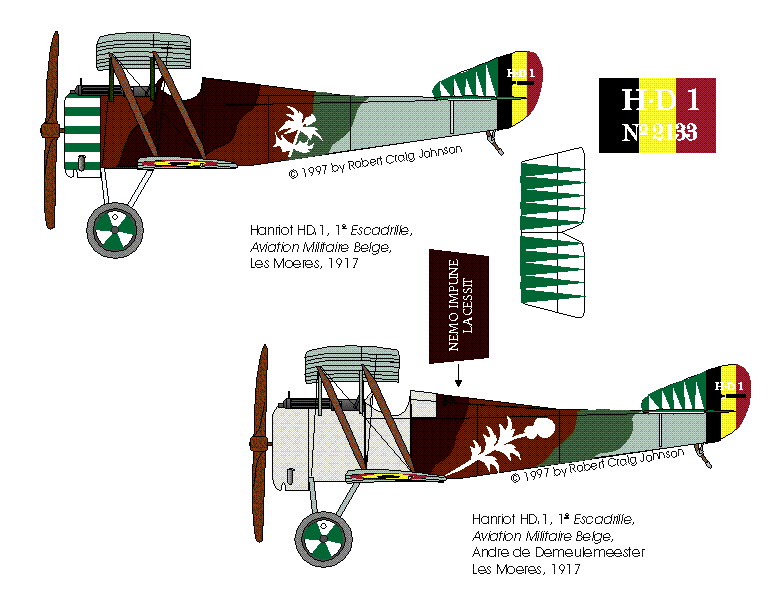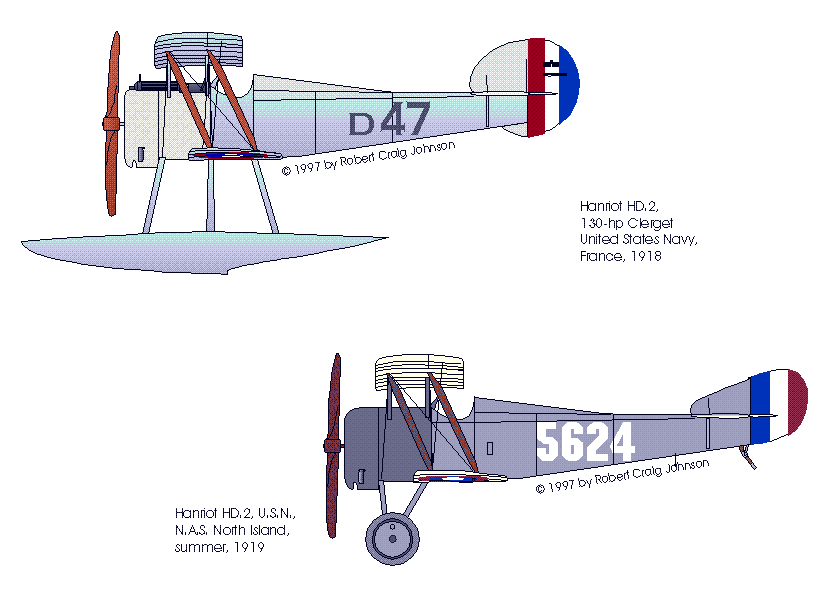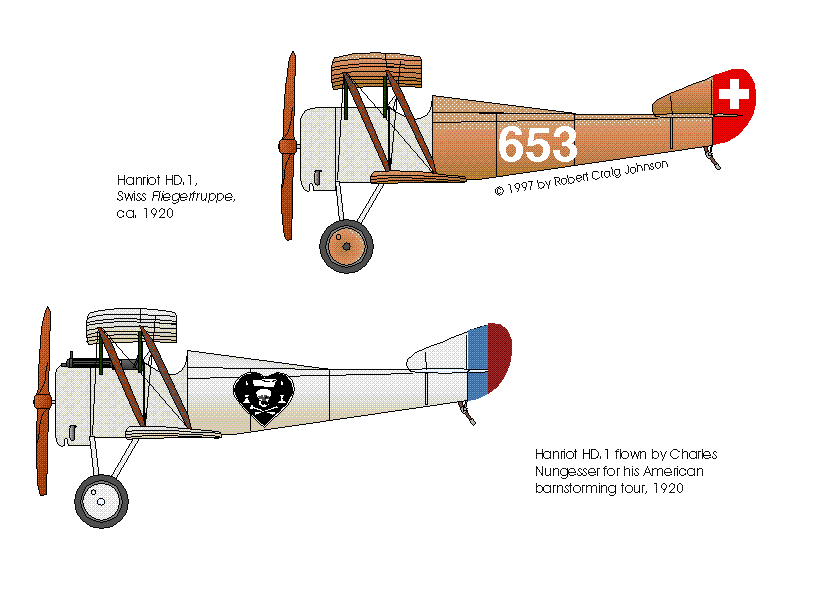
As we saw in the previous issue of Chandelle, the Hanriot HD.1 fighter was a comparative rarity in aviation history: a highly successful, high-performance aircraft that was never adopted by the country that developed it (aside from a few HD.2 floatplanes for the navy). The HD.1 came along at an awkward moment for a French fighter. It was just too late to compete with the Nieuports that formed the backbone of French fighter aviation in the first years of the war. By the time it appeared, it was eclipsed by the SPAD 7. The SPAD became the standard fighter of the French air force. The French did, however, allow Hanriot to market its new airplane to France’s allies. The major user of the HD was Italy, as we noted in our last issue. But Belgium bought a modest number, as did the U.S. Navy, and Switzerland used the HD.1 after the war.

Like the Italians, the Belgians chose the airplane as the successor to the Nieuport 17, their then standard fighter. All were, of course, French-built, since perilously little Belgian territory remained in Belgian hands after 1914. Belgium received 125 Hanriots, starting in June 1917. All the major Belgian aces flew them, including Willy Coppens, André Demeulemeester, Jan Olieslagers, and Edmond Thieffry. The Hanriots were not universally popular at first. Many felt that the aircraft was less maneuverable than the somewhat lighter and less powerful Nieuports it replaced. Few cared for the standard, French camouflage, one pilot dismissing it as a finish fit only for a wooden toy snake. But experience soon dispelled initial prejudices. The Hanriot was marginally faster, had a considerable higher ceiling, and enjoyed a generally sounder and more robust structure, uncompromised by the single-spar lower wing of Nieuport’s sesquiplane layout. By 1918, when England offered to replace all of the already obsolescent HD fighters with Camels, Belgium refused. The Hanriots soldiered on in Belgian service until 1926.
One or two Belgian Hanriots were the subject of an interesting and highly successful armament experiment. By 1917, the Hanriot's single .303-cal Vickers machine gun was seriously inadequate. Like the Italians before them, the Belgians experimented with twin Vickers guns, but found that performance suffered too severely with the extra weight. The single weapon was a particular liability during the balloon-busting sorties that were Coppens' specialty. With high-speed winches reeling in the target and zeroed-in antiaircraft guns firing at the attacker's aircraft, there was little time for the deliberate shooting that light-weight armament demanded. Accordingly, the French sent Coppens an early prototype of a new, purpose-built weapon, the "balloon gun." This was a license-built Vickers chambered for an experimental, high-velocity 11-mm (.45 cal.) cartridge (inspired, no doubt, by the standard, early-war anti-balloon weapon, a .45-cal, low-velocity incendiary bullet fired from a Victorian-era Martini-Henry carbine). Coppens had the gun fitted to one of his several Hanriots (No. 17) and used it alongside the standard machines. Coppens considered the experiment a great success. The 11-mm gun was far more effective than two of the standard 7.7-mm (.303 cal.) weapons but weighed less. At least one other Belgian Hanriot may have carried the gun, but the weapons never reached production due to the end of the war. Interestingly, the 11-mm balloon gun inspired one of the most successful automatic weapons of all times, the .50-cal (12.7-mm) Browning. The U.S. Army in France wanted to produce the French weapon in the USA for use against the armored loopholes of late-war German machine-gun nests and pill boxes. But, in a foretaste of the M-16 controversy of the 1960s, the Ordnance Department refused to accept the French cartridge without modifications, citing the allegedly sub-optimal ballistics of the 11-mm projectile. Ordinance set out to "improve" on the foreign product and, some years after the end of the war, came out with an altogether different but ultimately successful cartridge.
Belgian Hanriot's came finished in the standard, multi-colored French camouflage of the period. The colors have been described as dark brown, medium brown, medium green, and blue-grey or buff, brown, medium green, and dark green. Many Belgian machines were subsequently decorated with some of the most colorful unit and personal insignia seen on the Western Front.

Today, aviation enthusiasts tend to forget that the United States Navy operated combat aircraft in Europe, independently of the Marine Corps and the antisubmarine patrol effort. In 1918, the Navy bought ten examples of the new Hanriot HD.2 twin-float fighter. These were operated from the Allied seaplane station at Dunkerque against their German Navy counterparts at Ostend and Zeebrugge. In Flanders, the Hanriots were reportedly finished in a distinctive, light blue-grey unique to the USN. When the war ended, these aircraft were taken back to the United States and converted to landplanes, though retaining the HD.2’s larger fin and rudder in modified form. Together with Nieuport 28s, Thomas-Morse S4s, and a few Camels, these were used as experimental shipboard aircraft. During the 1920s, they were flown off platforms erected above the turrets of battleships throughout the early 1920s. At least one carried a large windmill generator mounted on the port lower wing. This may have been connected with early radio experiments. If so, it might tend to indicate that the Navy already saw battleship-borne airplanes primarily as reconnaissance assets.

Sixteen Hanriot HD.1s were sold to Switzerland in 1921. They were given Fliegertruppe serial numbers in the range 651-666 and based at Dübendorf, where a surviving example can still be seen. These aircraft were a solid buff color, perhaps the natural linen. The rudders were painted red and carried the Swiss cross insignia.

A number of Hanriot HD.1s also reached the United States, but as civil aircraft. The example shown below was brought over by none other than Charles Nungesser. The great French ace planned to use it for a barnstorming and lecture tour that American promoters promised would be a real money maker. It was not particularly successful, and the aircraft was eventually sold. It appeared in two of the great World War I flying movies, Wings and Hells Angels. Nungesser's aircraft was silver doped and painted with his well-known Jolly Roger personal insignia.
Notes for the modeler. The HD.1 has been released as a 1/72-scale injection-molded kit by Pegasus and, possibly, as a resin kit by Czech Masters. Eduard is planning to release an injected 1/48-scale kit sometime in the new year. A resin 1/48-scale kit was offered by JMGT.
J. M. Bruce. "Hanriot HD.1." Fighters. Warplanes of the First World War. Vol. 5: France. Garden City, NY: Doubleday, 1972. 3-11.
J. M. Bruce. The Hanriot HD 1. London: Profile Publications, n.d.
Alan Durkota. "A League of Modelers: The Hanriot HD.1." Over the Front (11[Summer 1996]:180-85).
Kenneth Munson. Fighters 1914-1919. New York: MacMillan, 1968.
© 1997 by Robert Craig Johnson.